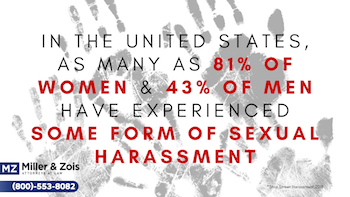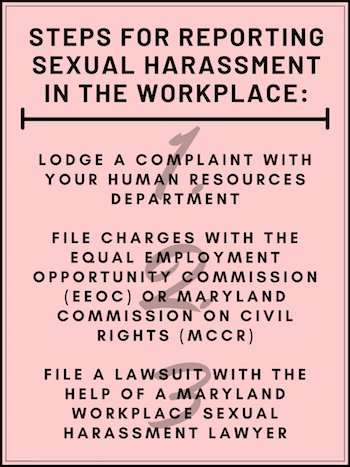
Everyone deserves to feel safe and respected in their place of work. Sexual harassment in the workplace creates a hostile environment, and when it is severe, pervasive, or affects the victim’s employment, is illegal. With the help of an experienced sexual harassment lawyer, victims have the legal right to complain to their employers about harassment, report harassment to government agencies, and even file a civil lawsuit against their employers when necessary.
Sexual harassment is broadly defined as unwelcome conduct of a sexual nature or that is directed towards a person’s gender. Examples include unwelcome sexual advances, groping, lewd comments, or discriminatory comments about gender. This is considered illegal when it creates a persistently offensive work environment or when it results in the victim being fired, demoted, or another adverse employment decision. Sexual harassment is not the same as sexual assault—sexual assault is one of several sex-related crimes that include rape, assault, bullying, and stalking. However, particularly violent sexual harassment may involve some of these offenses, such as unwanted sexual touching.
This article is intended to educate victims of sexual harassment about the options for reporting and litigating that are available to them. Follow the links below if you are interested in a specific topic.
Commonly Asked Questions
- How widespread is workplace sexual harassment the United States?
- What is the legal definition of sexual harassment in Maryland and in the United States?
- What help is available to victims of workplace sexual harassment in Maryland?
- Are victims allowed to remain confidential?
- How does Maryland law hold employers accountable for workplace sexual harassment?
- What are some tips I can follow to help my case be successful?
- Can I file a lawsuit over workplace sexual harassment in Maryland?
- How are sexual harassment lawsuits valued?
- Sample verdicts & settlements
- Hire a lawyer
How Widespread is Workplace Sexual Harassment in the United States?

In America today, as many as 81% of women and 43% of men have experienced some form of sexual harassment or assault. This statistic is disturbing for so many reasons. But among those reasons is the fact that sexual harassment, when it occurs in the workplace, affects the ability of thousands of women and men to achieve their full potential. In addition to its fundamental wrongness, sexual harassment in the workplace causes women to experience increased financial stress.
Something like 38% of women have experienced sexual harassment in the workplace. However, the true rate is difficult to accurately estimate. This is because many incidences go unreported by employees in order to avoid retaliation from their employers.
The Equal Employment Opportunity Commission (EEOC) is the principal federal agency that deals with discrimination in the workplace. In the 2019 fiscal year, there were 12,739 charges filed with the EEOC alleging sex-based harassment and 7,514 charges alleging sexual harassment. An example of sex-based harassment is frequently making derogatory jokes about women, while an example of sexual harassment is making repeated, unwanted sexual advances.
Women and men from all industries report sexual harassment. Though women always report much more frequently than men, women are more likely than men to report sexual harassment in industries that are more male-dominated. This indicates that women are more at risk of harassment in male-dominated industries, such as construction. Women in service industries and low-wage jobs are also at a higher risk.
Workplace sexual harassment is a problem that affects all of us on an ethical but also a practical level. For instance, sexual harassment is linked to general workplace inequality. Women make a fraction of what men make, even when they hold the exact same positions. On average, a woman in 2018 made 81.6 cents for every dollar a man made. For more proof that sexual discrimination and harassment hurts American livelihoods and families, look no further than the EEOC’s report that there were 2,753 receipts of pregnancy discrimination in the 2019 fiscal year.
What is the Legal Definition of Sexual Harassment in Maryland and the United States?
The Equal Employment Opportunity Commission (EEOC) enforces Title VII of the Civil Rights Act of 1964, a federal law which prohibits discrimination based on sex in employment. The Civil Rights Act also protects identities such as race and disability. According to the EEOC, “it is unlawful to harass a person because of that person’s sex.” This includes making unwelcome advances, asking for sexual favors, physical conduct of a sexual nature, and offensive remarks based on a person’s sex. The EEOC also says that for harassment to be illegal, it must be so pervasive and severe that it affects the work environment, or it must result in an employment decision such as the victim being fired.
A work environment is considered hostile if the inappropriate behavior was pervasive and severe. This means that investigators and courts will want to see how long the harassment was going on, if the acts were threatening or humiliating, and if the employee’s performance was affected. Despite this definition, a single act is enough to create a hostile work environment if the circumstances are particularly severe.
“Sexual harassment or harassment on the basis of sex in the workplace is illegal as enacted by Title VII of the Civil Rights Act of 1964”
In the State of Maryland, anti-discrimination law likewise addresses discrimination and harassment on the basis of sex. Maryland’s Fair Employment Practices Act was updated in October 2019 to
include a definition of harassment. Codified in MD State Govt. Code Sec. 20-601 et seq., the law defines harassment as including “harassment based on race, color, religion, ancestry or national origin, sex, age, marital status, sexual orientation, gender identity, or disability.” With that definition in mind, “[a]n employer may not…engage in harassment of an employee.”
You may also hear the term “quid pro quo” sexual harassment. Quid pro quo is a Latin term meaning something for something. This is when a supervisor demands an employee to perform a sexual favor in exchange for a promotion or threatens to fire an employee if they do not perform a sexual favor.
- Visit our page on sexual assault (i.e. rape and other sexual violence)
What Help is Available to Victims of Workplace Sexual Harassment in Maryland?

A first step that many victims of workplace sexual harassment take is lodging an internal complaint with their employer’s human resources department. Most employers have dedicated HR staff who investigate and resolve these issues. Complaining to HR, however, is not always effective.
If this is the case, a next step is to file charges with the EEOC or the Maryland Commission on Civil Rights (MCCR). No matter where you file, the EEOC and MCCR work together, and you can easily request that your case be cross-filed. These agencies will conduct an investigation to determine if discrimination occurred. If so, they will punish the company and award the employee damages.
If, on the other hand, the EEOC does not choose to get involved in the matter, they will give the employee the right to sue their employer. Then, the employee can file a lawsuit and attempt to receive compensation that way. You must go through the EEOC and receive the right to sue notice from them before you are allowed to file a federal lawsuit, and similar rules apply in many state jurisdictions.
A Maryland workplace sexual harassment attorney can help victims in any of these scenarios. Our experienced lawyers can help you at any stage, from promoting the success of your internal complaint to taking your case to the courtroom.
Are Victims Allowed to Remain Confidential?
An aspect that many victims want to know about before taking action is confidentiality. As a victim, you will have to give your personal information to the EEOC. The EEOC requires that a name appears on the charge that is sent to an employer. A person or an organization may file on your behalf, however, it may still be hard for you to remain anonymous. Know that it is illegal for an employer to retaliate (e.g. fire you) for filing a claim and that you can be reinstated or compensated if this occurs.
Additionally, the use of non-disclosure agreements by employers in these lawsuits has been the subject of controversy in recent years. Some argue that confidentiality agreements silence victims, while others argue that they are beneficial because they encourage employers to settle. In Maryland, one of the requirements of the “Disclosing Sexual Harassment in the Workplace Act of 2018” is that employers with more than 50 employees must report how many sexual harassment settlements they made that included a confidentiality provision.
How does Maryland Law Hold Employers Accountable for Workplace Sexual Harassment?
Changes made to Maryland employment law in October 2019 expanded employers’ liability for sexual harassment. Md. State Govt Code Sec. 20-611 outlines an employer’s liability for harassment. The statute says that an employer can be held legally responsible for harassment if the person who was responsible for the harassment was in charge of supervising, directing, or evaluating the work of the employee who was harassed, or if they were in charge of employment decisions (promoting, firing, etc.). An employer is also liable if their negligence led to the harassment or the continuation of the harassment.
“Employers in Maryland can be held responsible for sexual harassment, especially when they knew that the harassment was happening and did nothing to stop it.”
With the recent changes to Maryland statute, there is no minimum number of employees an employer must have for this statute to apply—previously, an employer had to have 50 employees to be liable for harassment. Additionally, employers are now liable for harassment experienced by their independent contractors. Finally, the time limit to file with a local human relations commission was expanded from 6 months to 2 years, and the statute of limitations to file a lawsuit was expanded from two years to three years.
The “Disclosing Sexual Harassment in the Workplace Act of 2018” put in place new reporting requirements for Maryland employers. The act requires employers to report the number of settlements they have made to resolve sexual assault allegations by July 1, 2020, and again by July 2, 2022. Another key part of this act is that employers are no longer allowed to include a provision in an employment contract that prevents an employee from reporting sexual harassment. Nor can an employer retaliate against an employee who refuses to sign a contract that includes such a provision.
What are Some Tips I can Follow to Help my Complaint be Successful?
First, follow your workplace’s company policy for reporting, if such a policy exists. If there is no policy, report what is going on to a higher-level manager or human resources.
Secondly, it is best to report harassment in writing so that you can get down as many exact details as possible. Include a description of how the harassment has affected your work. Also, keep written notes documenting your experiences, noting the time, place, who was involved, and what was said or done. This will help build your case that the sexual harassment was severe, pervasive, and created a hostile environment. You should write “in contemplation of litigation” at the top of your notes to ensure that the other side cannot access them in the event that you file a lawsuit.
One way to increase the likelihood that your complai
nt will be taken seriously is to complain as a group. If your coworkers have similar complaints and are willing to come forward with you, it will be much harder for your employer to discredit or ignore you.
Finally, if reporting internally does not improve the situation, seek legal advice. An attorney will help you file a discrimination charge with the EEOC or MCCR if you wish to do so. Note that the deadline to report to the MCCR is 6 months from the date the last harassment occurred. Maryland’s EEOC office also has a filing deadline of 180 days if your workplace employs less than 15 people and 300 if your workplace employs more than 15 people. If the EEOC decides not to take your case, they will issue a document giving you the right to file a lawsuit. The deadline to file a lawsuit in federal court after the EEOC has issued this document is 90 days. On the Maryland state level, you must file a lawsuit with the circuit court within 2 years of when the harassment occurred.
Can I File a Lawsuit Over Workplace Sexual Harassment in Maryland?
Yes. Litigation is often the last resort for victims. If internal complaints or filing a discrimination charge with the EEOC or MCCR goes nowhere, filing a civil lawsuit is the next step. At this point, working with an experienced attorney is strongly recommended in order to avoid legal traps and win the best possible settlement.
To file a lawsuit, you have to file a discrimination charge with the government first. The EEOC, for example, will give you the right to proceed with a lawsuit after it decides not to proceed with your case. You must file your federal lawsuit within 90 days after getting the go-ahead. In Maryland, if the MCCR does not move forward with your case in 180 days, you can move ahead with a lawsuit in the Maryland circuit court. You must file within 2 years of the latest incident of harassment.
How are Sexual Harassment Claims Valued?
In a civil lawsuit, the “damages” are the monetary compensation that plaintiffs are awarded. In a sexual harassment claim, these are the possible types of damages:
- Back pay (Wages and other compensation you would have received if the harassment had not resulted in you being fired or denied a raise or promotion — these same victims also often have wage and hour claims for lost overtime and other violations)
- Front pay (Future wage loss, e.g. if you were fired and reinstatement is not an option)
- Compensatory damages (Includes pain & suffering, harm to your reputation, medical bills, and job search costs)
- Punitive damages (Damages intended to punish the defendant for their actions or negligence)
- Attorney’s fees
“Victims of workplace sexual harassment can be compensated for the wages and career opportunities they lost, the harm done to their reputation, and their pain and suffering.”
Compensatory and punitive damages are the most subjective type of damages. It is challenging to put a price on a person’s pain and suffering. However, the federal government has a cap on compensatory and punitive damages. This means that even if a jury awards millions of dollars, what the plaintiff receives may actually be much less. The cap depends on the size of the company:
- $50,000 for employers with 15-100 employees
- $100,000 for employers with 101-200 employees
- $200,000 for employers with 201-500 employees
- $300,000 for employers with more than 500 employees
Researchers suggest that a much higher cap would incentivize workplaces to take this issue more seriously, similar to how a higher cap on workers’ compensation damages did the same in the past.
Sample Verdicts & Settlements
- 2020, Maryland (Baltimore): $74,000 A concrete company was sued twice by the EEOC for discrimination charges. The first lawsuit alleged that the owner of the company frequently used racial slurs and fired a female secretary when she complained. In the second lawsuit, a male concrete finisher said that he was subject to racial and sexual harassment while employed by the company, including explicit sexual comments, racial slurs, groping, and physical threats. The company settled with the EEOC, paying $44,000 to the secretary and $30,000 to the concrete finisher. The company must also provide Title VII policies and training to employees along with a notice about the settlement. It also must report how it handles internal complaints to the EEOC.
- 2020, Tennessee: $150,000 Verdict A truck driver alleged that her supervisor sexually harassed and assaulted her. The supervisor was assigned to train her, meaning that they spent thousands of miles on the road together. The plaintiff alleged that the supervisor sexually assaulted her during work hours. She reported the incident to her supervisor’s superior, who initiated an investigation. The supervisor contended that she was lying about the sexual assault. She then experienced further sexual harassment. This culminated in another incident two months later. The company offered to hire the truck driver’s boyfriend, who was also a truck driver. The boyfriend declined as he was already employed. As a response, the employer terminated the truck driver’s employment. She sued the trucking company, alleging sexual harassment and retaliation for her complaint. Her former employer contended they offered to fire the supervisor and claimed that she agreed to continue working with him. They also denied retaliation, claiming that she chose to quit. The jury gave a mixed verdict and the former truck driver received $150,000, which included $50,000 in back pay and $100,000 in punitive damages.
- 2019, California: $58,250,000 Verdict The plaintiff, a production assistant, accused the production company’s owner of groping and making her perform degrading acts. She alleged that he would grab her neck and force it towards his groin. She also alleged that he groped her several times. She further alleged that he performed a lap dance on her while they were in front of a client. He also made lewd comments almost every day at work. She resigned the following year. The woman claimed that she became reclusive and gained 30 pounds. Her expert psychologist testified that she experienced post-traumatic stress disorder as a result of her former employer’s actions. He opined that she might benefit from therapy but doubted that she could fully recover. The jury ruled in favor of the woman, who recovered $58,250,000 in damages.
- 2019, Texas: $340,000 Settlement The Equal Employment Opportunity Commission sued a McDonald’s franchisee, alleging that two male employees made inappropriate comments and physical contact with eight female employees. This included lewd jokes and the display of pornographic images. The EEOC claimed that management knew of this and did nothing to stop it. The settlement decreed that $240,000 was to be paid to the eight women and $100,000 for other female employees subjected to such harassment. It also required the franch
ise owner to take measures to stop future sexual harassment. - 2019, Pennsylvania: $510,000 Verdict A Midas technician alleged that her boss sexually harassed her. She also alleged that the district manager also sexually harassed her after making a complaint. The plaintiff claimed that she was sexually harassed every day while working at that specific Midas location for nine months. Her boss threatened to fire her if she reported the harassment. The lawsuit included this retaliation claim in addition to her allegations. The Midas location contended that she only worked there briefly and that she quit her job for reasons unrelated to sexual harassment. They also questioned her reliability and credibility, claiming that she could not hold a steady job. The jury ruled in favor of the technician and awarded her $510,000.
- 2019, Kansas: $600,000 Verdict The plaintiff, a Kansas City-area barbecue restaurant dishwasher, alleged that her manager sexually harassed her. Specifically, she alleged that he made sexual gestures and comments to her. This culminated with the jealous manager knocking her down while she was outside making a phone call. She also made a worker’s compensation claim. She sued the establishment for several counts including sexual harassment, retaliation for reporting harassment, worker’s compensation retaliation, and failing to accommodate her disabilities. Her disability claim pertained to the injuries caused by her manager’s assault. The jury ruled in favor of the dishwasher for sexual harassment and disability but ruled in favor of the establishment for retaliation and worker’s compensation. The verdict initially totaled $600,000 but was reduced to $300,000 as a result of the jury’s ruling concerning the worker’s compensation retaliation.
- Maryland, 2018: $200,000 Settlement The EEOC filed a lawsuit against a Maryland restaurant on behalf of a female employee. She and at least three other employees experienced sexual harassment while employed at the restaurant. The owner frequently made sexual comments to these women and engaged in unwanted sexual touching. When one employee reported him, she was fired. The plaintiff in this lawsuit was raped by the owner on one occasion. As part of the settlement, the restaurant was told to pay $200,000 to her and others in a class of employees who were also harassed. The restaurant was also assigned an independent monitor and was required to supply policies prohibiting sexual harassment to its employees as well as post a notice about the settlement.
- Maryland, 2018: $90,000 Settlement The plaintiff is a woman who works as a temporary employee at a plastics manufacturer. Her male coworker, who she worked with every day, made sexual advances which she denied. After this incident, the male coworker began reporting her to their supervisor for infractions that never occurred. When she complained about him, she was fired. The EEOC filed this claim on behalf of the temporary worker, and the parties settled quickly for $90,000.
Hire a Lawyer 
At Miller & Zois we are sensitive to the issues faced by victims of sexual harassment and work hard to get victims the settlements they deserve. You can call our sexual harassment attorneys at 800-553-8082 for a confidential, free consultation of your case and your options. You can also complete this online form and our legal team will respond. Our office is located in Baltimore, Maryland.
 Maryland Personal Injury Lawyers
Maryland Personal Injury Lawyers





